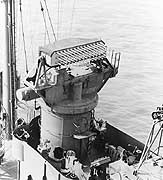![]() The Pacific War Online Encyclopedia
The Pacific War Online Encyclopedia
|
| Previous: Mariveles | Table of Contents | Next: Mark 27 Fire Control Radar |

Naval
History
and Heritage Command #NH 84813
| Wavelength | 10 cm |
| Scan rate |
10 scans per second across 30 degree swathe |
| Power | 15-20 kW, later 20-30 kW |
| Range | 40,000 yards or 36,600 meters (BB) 31,000 yards or 28,000 meters (DD) Minimum range 500 yards |
| Antenna |
14x3 element MUSA (multi-unit-steerable-antenna) array |
| Scope |
A and B scopes |
| Accuracy | 15 yards/2 mils 14 meters/2 mils |
| Resolution | 400 yards/10 degrees 370 meters/10 degrees |
| Production |
205 by 1943 |
The Mark 8 (FH) fire control radar was used to direct large-caliber cruiser and battleship guns. Its design dated to 1941, but the previous FC and FD radars were good enough that deployment of FH to the fleet took place at a relatively leisurely pace. It was the first operational radar to make use of the phase array principle, using mechanical switching to alter the phase relationships between different elements to steer the beem without physically moving the antenna. Though it gave no useful altitude information, it had remarkable accuracy in both range and bearing, making it ideal for fire control against surface targets. Its rapid scan of a 30 degree arc simplified acquisition of targets.
One drawback of the Mark 8 was the complexity of its antenna
array, which prompted development of the postwar Mark 13 parabolic
antenna.
Its combat debut came at Surigao
Strait, where the three battleships equipped with the radar (West Virginia, Tennessee, and California) were the first to acquire
targets and did almost all of the shooting.
References
Goebel (2011;
accessed 2012-5-3)
Morison (1958)
NavSource.org (accessed 2012-5-3)
The Pacific War Online Encyclopedia © 2007, 2009, 2013, 2018 by Kent G. Budge. Index